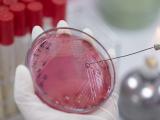Jan 11, 2013
Study: 2% of flu viruses from 2008 to 2011 were antiviral-resistant
The first 3 years of data from the Influenza Resistance Information Study that began in 2008 show that resistance to the neuraminidase inhibitor (NI) class of antiviral drugs was 2.2% overall and mostly found in patients 1 to 5 years old, according to a report yesterday in Clinical Infectious Diseases. The study, which included 1,799 lab-confirmed influenza cases, also found that all 47 seasonal H1N1 viruses tested (not pandemic 2009 H1N1, or pH1N1) were resistant to NIs, which include the commonly prescribed oseltamivir (Tamiflu) and zanamivir (Relenza). Of the patients, 1,281 had influenza A (47 seasonal H1N1, 335 H3N2, and 899 pH1N1) and 518 had influenza B. NIs were distributed to 1,041 (58%) of the patients (26, 245, 514, and 256, respectively). All seasonal H1N1 strains were genotypically and phenotypically resistant to oseltamivir, but no genotypic resistance was detected in samples of any other subtypes taken on the first day of symptoms (baseline). Mutation-specific polymerase chain reaction, however, detected resistance to oseltamivir in 19 patients (17 pH1N1, 2 H3N2) post-baseline, 14 of whom were kids 5 and younger.
Jan 10 Clin Infect Dis abstract
DARPA grant supports flu evolution study
A University of Massachusetts Medical School research team has received a $12 million grant from the Defense Advanced Research Projects Agency (DARPA) to develop new ways to predict flu virus changes from antiviral drug and immune system pressures. The project is led by Robert W. Finberg, MD, chair and professor of medicine at the school, according to a press release yesterday from the school. One approach is to conduct deep genetic sequencing of the flu virus before and after it is exposed to a pressure such as an antiviral drug. Finberg said in the release that he hopes the work will help predict how the virus evolves to escape immune system defenses. Determining what the future flu viruses will be might improve the accuracy of selecting the strains likely to cause severe disease in humans, which could lead to a better targeted vaccine, according to the release.
Jan 10 UMass Medical School press release
Scientists develop PCR test for fungal meningitis pathogen
US scientists have developed a real-time polymerase chain reaction test for rapidly detecting Exserohilum rostratum, the pathogen primarily responsible for hundreds of cases of fungal meningitis from tainted vials of methylprednisolone acetate. The assay was highly accurate and detected the fungus efficiently, according to a study in the Journal of Clinical Microbiology. Researchers tested the assay on seven separate isolates of E rostratum, and the test was able to detect the pathogen in amounts as small as 100 femtograms. The team was also able to detect three closely related species: E longirostratum, E mcginnisii, and E gedarefense.
Jan 9 J Clin Microbiol abstract
Yellow fever cases in Sudan reach 849; vaccination drive progresses
The count of yellow fever cases in the Darfur region of Sudan has reached 849, with 171 deaths, and the second phase of a vaccination campaign there is nearly complete, according to a Jan 10 ReliefWeb report from the United Nations Office for the Coordination of Humanitarian Affairs. The report, citing the Sudanese government and the World Health Organization (WHO), said the epidemic has affected 35 localities throughout Darfur. The case-fatality rate is 20.1%. Phase 2 of the vaccination drive has reached about 1.1 million people, or 93% of the targeted population in South, West, and Central Darfur. The report said the WHO has recommended a third-stage vaccination drive targeting about 2 million people. The first shipment of vaccine for that effort, 670,400 doses, is scheduled to arrive Jan 14. In other activity, blood sampling for a national yellow fever risk assessment was completed on Dec 29 with the collection of 1,754 samples from eight sites. The samples will be analyzed at the National Public Health Laboratory in Khartoum.
Jan 10 ReliefWeb report






















